Evaluation of Zohreh River Water Quality, Impacted by Natural and Anthropogenic Pollution Sources, Using Multivariate Statistical Techniques
Maryam Ravanbakhsh1, Yaser Tahmasebi Birgani1,2*, Maryam Dastoorpoor3 and Kambiz Ahmadi Angali4
1Department of Environmental Health Engineering, School of Health, Ahvaz Jundishapur University of Medical Sciences, Iran
2Environmental Technologies Research Center, Ahvaz Jundishapur University of Medical Sciences, Iran
3Department of Medical Virology, Faculty of Medicine, Ahvaz Jundishapur University of Medical Sciences, Iran
4Department of Biostatistics, Ahvaz Jundishapur University of Medical Sciences, Iran
Submission: December 18, 2018; Published: January 18, 2019
*Corresponding author: Yaser Tahmasebi Birgani, Department of Environmental Health Engineering, School of Health and Environmental Technologies Research Center, Ahvaz Jundishapur University of Medical Sciences, Iran
How to cite this article: Maryam R, Yaser T B, Maryam D, Kambiz A A. Evaluation of Zohreh River Water Quality, Impacted by Natural and Anthropogenic Pollution Sources, Using Multivariate Statistical Techniques. 2019; 16(3): 555936. DOI:10.19080/IJESNR.2019.16.555936
Abstract
Discriminant analysis (DA) and principal component analysis (PCA) as a multivariate statistical technique, were applied for the evaluation of temporal and spatial variation and the interpretation of a large complex water quality data set of the Zohre river basin, monitoring 16 water quality parameters collected over 16 - 45 years (1966 - 2013), in four stations sites (1554 observations for each parameter). Principal component analysis, applied to the data sets of the four studied stations resulted in four, four, four and three latent factors explaining 78.985, 83.828, 77.648, and 77.68 % of the total variance in water quality data sets of Kheirabad, Poleflour, Chambostan and Dehmolla stations, respectively. The factors obtained from PCA analysis indicate that the parameters responsible for water quality variations are mainly related to TDS, EC, Cl, Na, SAR and %Na (natural sources included Gypsum and salt crystal are frequently grown in supratidal, intertidal zones of Zohreh delta and Chamshir faults I and II fault zone, and anthropogenic source caused by sugarcane culture withdrawals, discharging of domestic and industrial wastewaters) in all studied stations. DA provided an important data reduction as it uses only seven parameters (discharge, temperature, electrical conductivity, HCO3- , Cl, %Na and T-Hardness), affording more than 58.5% correct assignations in temporal analysis. Therefore, DA allowed a reduction in the dimensionality of the large data set, describing a few indicator parameters responsible for large variations in water quality. So, this study shows the advantages of multivariate statistical techniques for analysis and explanation of complex data sets, and in water quality assessment, recognition of pollution sources/factors and understanding temporal variations in water quality for proper management of river water quality.
Keywords: Zohre river basin; Water quality; Principal component analysis; Discriminant analysis
Introduction
A river is considered as a system compose of the primary course and branches in which a considerable amount of matter in dissolved and particulate phases resulted from either natural or anthropogenic sources is carried as one-way flow. There are multiple factors including the atmospheric and anthropogenic inputs, the basin lithology and climatic conditions may impact on the quality of a river water Bricker and Jones [1]. It is indicated that rivers have important role in collection and transportation of municipal and industrial wastewater and runoff from a farming land. The discharge of municipal and industrial wastewater makes a constant polluting source, while the surface runoff is considered as a seasonal event, mainly influenced by climate variations KP Singh, Basant, Malik and Jain [2]. Seasonal changes including precipitation, interflow, surface runoff and groundwater flow pumped in and out flows are main factors influence river discharge and, finally, on the concentration of pollutant in river water Vega, Pardo, Barrado and Debán [3]. Therefore, having a proper and precise information regarding with hydro- morphological, chemical and biological characteristics may be needed in order to effective and long-term management of rivers. However, regarding with spatial and temporal changes in water quality, a monitoring program may be necessary to provide a representative and valuable evaluation of the quality of surface waters, which are often difficult to interpret Dixon and Chiswell [4].
Several multivariate statistical techniques including principal component analysis (PCA) and discriminant analysis (DA) are useful for interpretation of complicated data matrices in order to evaluation the quality and ecological status of river systems and determining the possible factors or sources impact on water systems. This method may led to a valuable approach for credible water resources management and instant solutions for pollution problems Barakat, El Baghdadi, Rais, Aghezzaf and Slassi [5], Fan, Cui, Zhao, Zhang and Zhang [6], Iscen [7], Magyar [8], Vega [3], Wang, Liu, Liu and Lam [9]. Simeonov [10] assessed the surface water quality by application of various multivariate statistical analysis for the interpretation of a huge and complex data set obtained from a monitoring plan of surface waters in Northern Greece. This study showed the requisite and utility of multivariate statistical analysis in large and complex databases to gain more information about the surface water quality, the planning of sampling and analytical protocols and the impressive pollution control/management of the surface waters Simeonov [10]. Singh and et al studied river Yamuna (as the main river of India). The management of Yamuna river water quality using statistical, trend, and time series analysis has been evaluated KP Singh and Bhardwaj [11]. Similarly, Razmkhah and et al evaluated the spatial and temporal variation of Jajrood River (Tehran, Iran) water quality. The results demonstrated that plots in PCA could approximately demonstrated temporal and spatial variations clearly Razmkhah, Abrishamchi and Torkian [12]. In the present study a large data matrix, obtained during a 45-year (1967 to 2013) monitoring program, is subjected to different multivariate statistical techniques to show information about studied variations between sampling stations, recognition of water quality variables accountable for spatial and temporal differences in river water quality and the effects of possible sources (natural and anthropogenic) on water quality parameters of the Zohreh river basin.
Methods
Study area
Zohreh river basin area drained by Zohreh River is located in the southwest of Iran (Figure 1). This basin with 13012 Km2 surface area, is located between 29°59′–30°15′ and 49°25′–49°50′. Zohreh River is one of the longest watercourses in Iran, originated from southwest of Bushehr province at Mamasany city and flows into Khuzestan province. Zohreh River is limited to Maroon and Jarrahie watershed Basin from north and to Karoon, Kor and Genaveh watershed Basin from south and finally impounds into the Persian Gulf. The river catchment area is 16,033 km2 and is divided into mountainous (10,789 km2), lowland (5244 km2) and coastal areas Ahmadi, Ravanbakhsh, Ahmadi and Ramavandi [13]. The mean and annual discharge values for the Zohreh River water are 87 m3 s−1 and 2729 million cubic meters (MCM), respectively. Also, the Zohreh River annual averages of sediment discharge, evaporation and rainfall rates are 8 million ton (Mt), 3471 and 200 mm respectively Gharibreza, Habibi, Imamjomeh and Ashraf [14]. It is a major source for agriculture and industrial activities located in downstream areas and drain the major agricultural (2300.97 Mm3/ y), drinking and cattle breeding (78.108 Mm3 / y), and industrial (11.2 Mm3/ y) activities in Khuzestan Province and during its course of 490 km, receives a pollution load from both point and non-point sources Ahmadi [13].
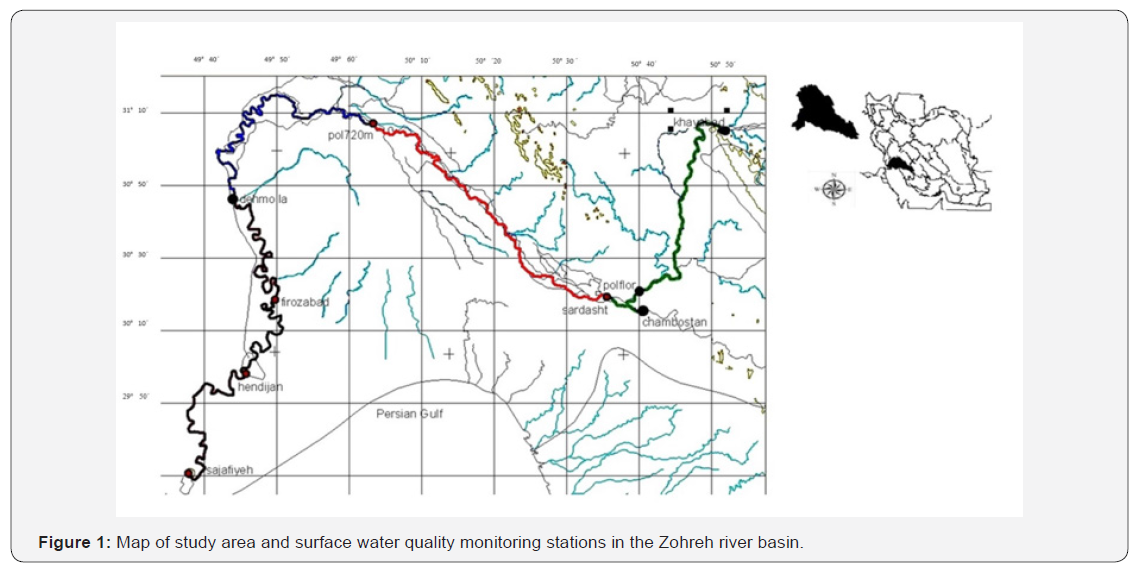
Monitored parameters and analytical methods
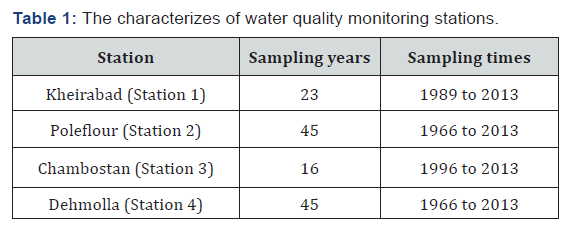
The data sets of 4 water quality monitoring stations (Table 1), comprising 16 water quality parameters monitored monthly over 16 - 45 years (1966 - 2013), were obtained from the Khuzestan water and Power Institute. The Ministry of Power of Iran operates and maintains stream-flow gauging stations has been collecting various water quality parameters from several water quality monitoring stations. However, only 16 parameters in 4 stations are selected due to their continuity in measurement at all selected water quality monitoring stations. The selected water quality parameters include river water discharge(Q), water temperature(T), Total dissolved solids (TDS), Electrical Conductivity (EC), Bicarbonates (HCO-3), Sulfates (SO4 -2), Chlorides (Cl−), Sodium (Na), Potassium (K), Magnesium (Mg), Calcium (Ca), Total Hardness (T-Hard), Ca hardness (Ca-Hard), pH, Sodium Absorption Ratio (SAR) and Sodium percentage. The basic statistics of the monthly measured data set on river water quality are summarized in Table 2.
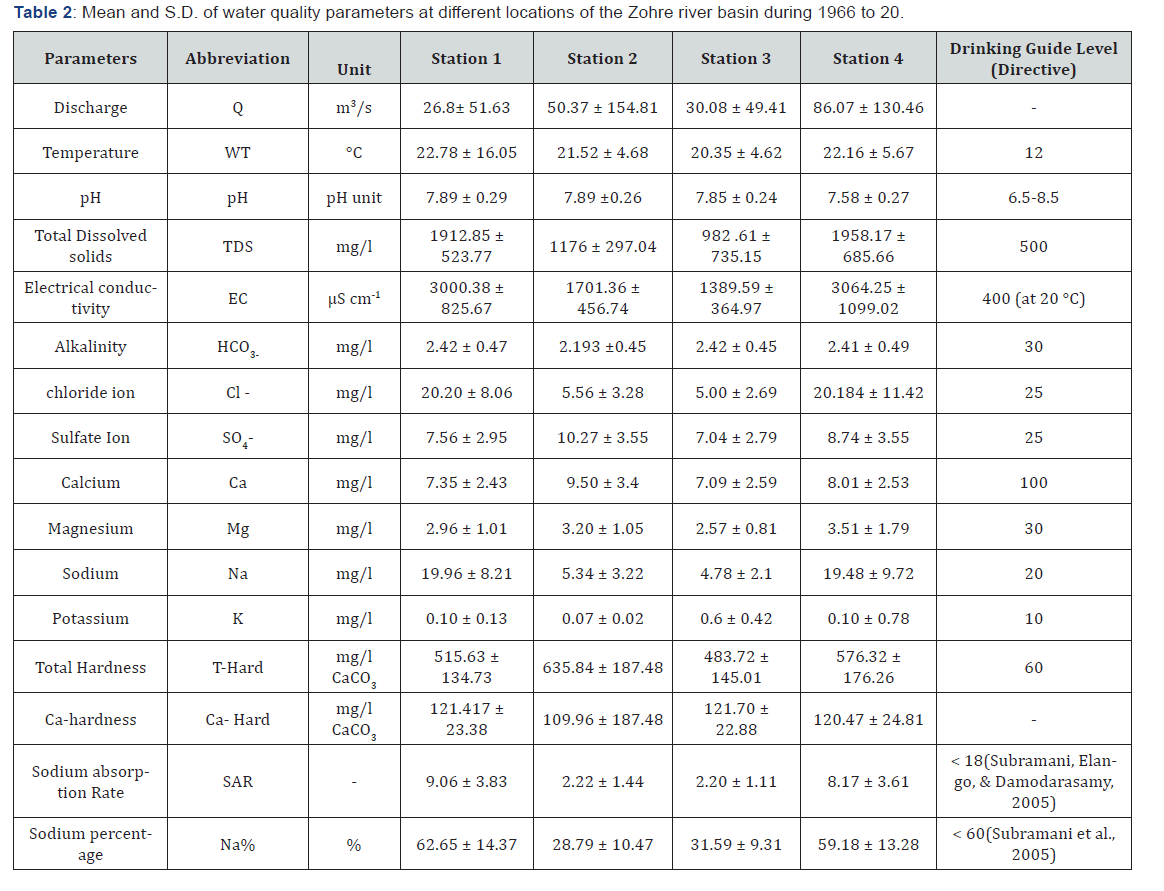
Data treatment and multivariate statistical methods
The Kolmogorov–Smirnov (K-S) test evaluated the goodness of the water quality parameters fit to a normal distribution with 95% or higher confidence. The relationship between parameters commonly, was assessed by Correlation analysis Alberto [15]. In this study, temporal variations of Zohreh river water quality parameters were assessed by parameter correlation analysis, then, grouped into four seasons: spring (March -May), summer (June - August), autumn (September- November) and winter (December- February) to subjected to use in discriminant analysis (DA) and principal component analysis (PCA) multivariate technique. Discriminant analysis is used to specify the variables that discriminate between two or more naturally arising groups. The raw data used and the technique creats a discriminant function for each group as equation below Alberto [15], KP Singh, Malik, Mohan and Sinha [16]

where i is the number of groups (G), ki is the constant inherent to each group, n is the number of parameters used to classifya set of data into a given group, wj is the weight coefficient, assigned by DA to a given selected parameter (pj). In current study, temporal (spring, summer, autumn and winter) and spatial (four sampling stations) distribution have been evaluated by DA. Discriminant analysis was applied to raw data in order to evaluate both the spatial and temporal variations in Zohreh river water quality to build discriminant functions. The stations (spatial distribution) and the season (temporal distribution) were the grouping as dependent variables, and all the measured physical water quality parameters formed the independent variables and statistically assessed by SPSS 16 software. PCA technique used to derive the eigenvalues and eigenvectors (which is a list of loadings or weightings coefficients) from the covariance matrix of original variables. The principal component is the uncorrelated (orthogonal) variable that calculated by multiplying eigenvector with original correlated variables. So, the PCs are the weighted linear concoction of the original variables. PCs generate information on the most significant parameters. This information explains whole data set that led to data reduction with lowest loss of initial information Helena [17], Razmkhah [12], Vega [3]. It is a strong technique for pattern recognition that try to show the variance of a vast set of inter-correlated. The principal component (PC) can be demonstrated as:

where z is the component score, a is the component loading, x the measured value of variable, i is the component number, j the sample number and m the total number of variables.
Results and Discussion
Zohre river water characterization
Table 2 provides a summary of the mean value, standard deviation of 16 measured variables in the river water samples at 4 stations and the recommended guide and maximum level allowed by the European Directive 80/778/EEC [18] for water quality predesignate for human consumption. It must be indicated that the mean concentration of some variables such as T, TDS, EC and T-Hard were higher than those recommended by the European Directive 80/778/EEC, at all stations. The pH values of groundwater range from 7.5 to 7.8 in all stations during the sampling periods. This showed that the water of Zohreh River is mainly neutral in nature. The EC values were ranged from 1700 to 3064 μS/cm. higher values are generally noticed in statins 1 and 4 area. TDS values range from 982 to 1958 mg/l that were significantly higher in stations 1 and 4 which were similarly to EC values. The abundance of the major ions in river water was in the following order:

In order to assess the river water quality for agricultural activities Electrical conductivity is a good scale of salinity hazard to crops. Surplus salinity decreases the osmotic activity of plants and led to intervenes in the water and nutrients absorption from the soil. Sodium adsorption ratio (SAR) is an important parameter for showing the compatibility of groundwater for irrigation because it measures the alkali/sodium hazard to crops. High concentration of sodium in irrigation water, led to absorption of sodium ions be by clay particles, dislocating by Mg2+ and Ca2+ ions. This exchange process causes the low soil permeability and eventually results in soil poor internal drainage. Hence, air and water turnover are lemitted during wet conditions and when such soils dried get usually hard Collins and Jenkins [19]. In station 1 the Sodium percentage was higher than permissible limits.
Temporal variations in river water quality
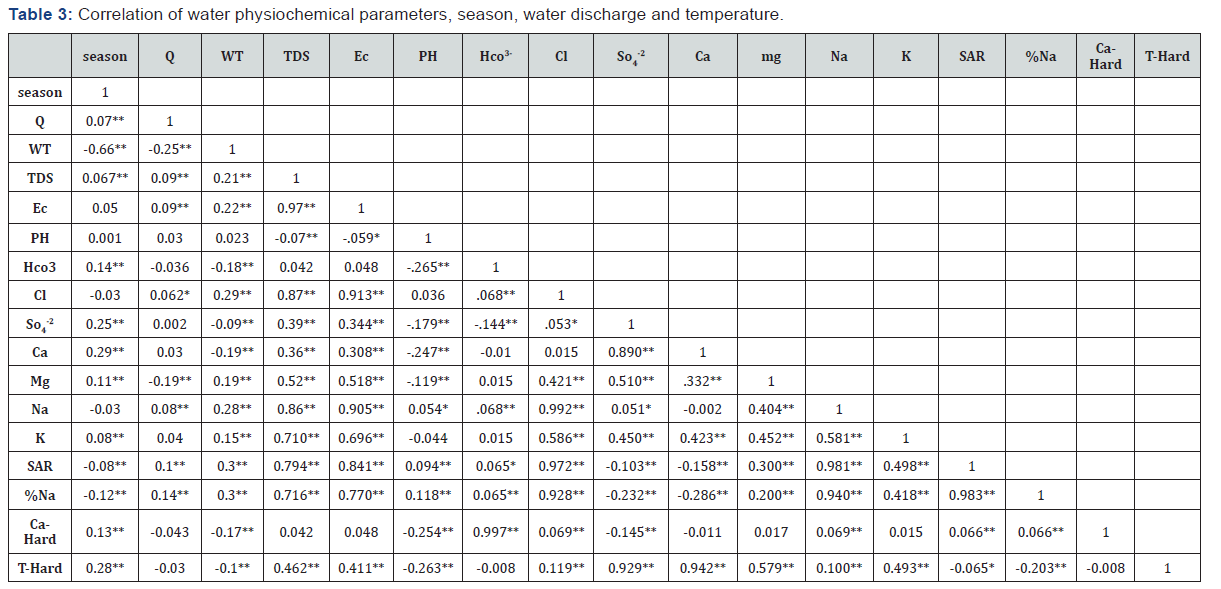
Temporal variations in Zohreh river water quality parameters were assessed by correlation analysis (Table 3). The results show that all the 16 studied parameters were correlated significantly with season (p < 0.01), except EC, pH, Cl and Na. It could be suggested that anthropogenic pollution sources led to variation in water salinity and pH sources in the catchment areas. According to results, temperature showed highest correlation coefficient (Spearman’s R = - 0.66) followed by Ca (Spearman’s R= 0.29). The major source of temporal variations in Zohreh water quality can be attributed to the season- correlated parameters. vast seasonal differences in temperature can be assigned to the high seasonality in varied water quality parameters K P Singh [16]. The catchment area is located in arid and semi-arid zones in Khuzestan province, Iran. Khuzestan has a long summer with a short moderate winter. The maximum temperature of the region is 52 °C the minimum is 1°C Ahmadi [13]. The average discharge (Table 2) is highest in station 4 sites as they receive discharge from the major tributaries, domestic wastewater and water withdrawal for irrigation located in city areas. The river water temperature is highest in station 1 and fallowed by station 4, as they receive discharge from domestic wastewater, wastewater treatment plants effluents and agricultural irrigations located in city areas, which increase water temperature. The concentration of EC (Table 2) may resulted from high loading of dissolved organic matter in the stations 1 and 4 due to the discharge of raw and treated domestic wastewater from plants located at the upstream areas of the monitoring stations. The concentration of Na, Cl and TDS are similarly high in stations 1 and 4which confirm the high load of water withdrawal for irrigation located in the Zohre basin.
To evaluate temporal variations in water quality, the discriminate analysis were applied. First step was dividing of the all data set into four seasonal groups (spring, summer, autumn and winter), followed by next step; temporal DA performance on raw data. Discriminant functions (DFs) and classification matrices (CMs) are shown in Tables 4 & 5. Table 4: Discriminant functions of for
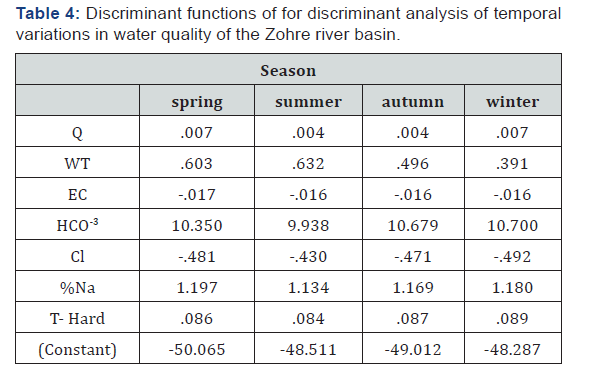
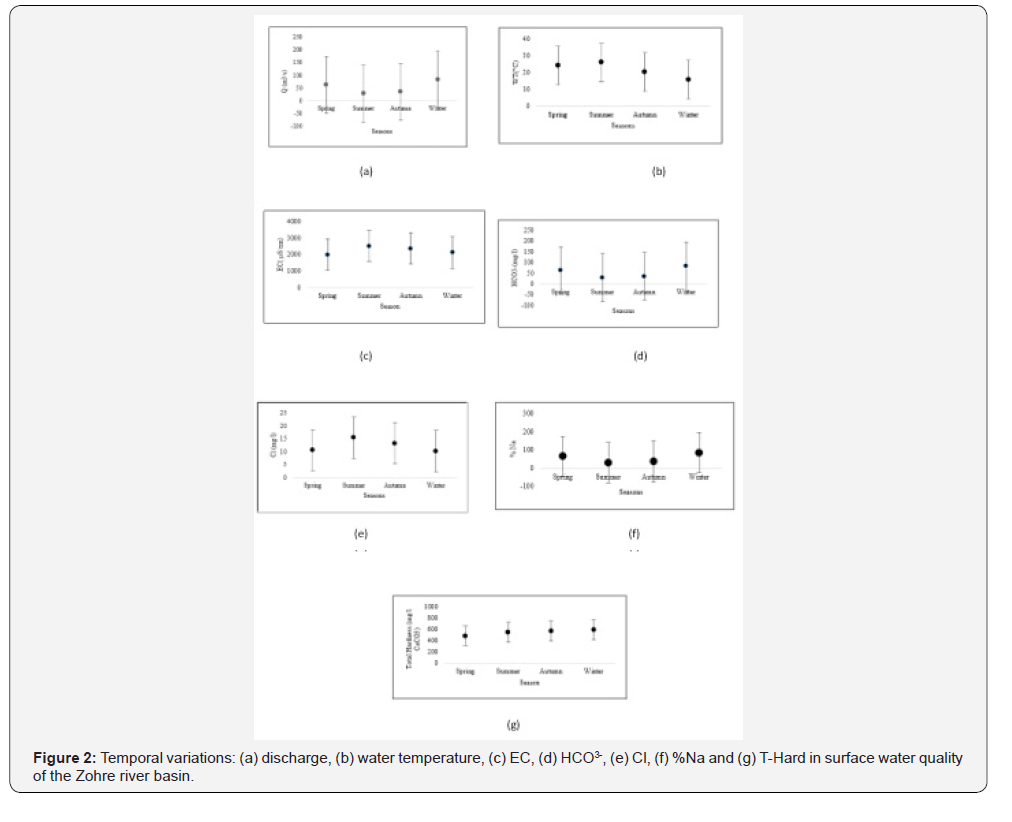
DFs including 7 parameters (Table 4). The standard DFs using 7 discriminant variables, yielded the corresponding CMs allocating 58.5% of the cases correctly (Tables 4 & 5). According to the temporal DA results, Q, WT, EC, HCO3- , Cl, %Na and T-Hard are the most significant parameters to discriminate between the four seasons, which means that these seven parameters are responsible for most expected temporal variations in the Zohreh river water quality (Table 5). The plots of the selected parameters resulted by DA are illustrated in (Figure 2). The average of Zohreh river water discharge (Figure 2a) is higher in more precipitation seasons (spring and winter) in compared with autumn and summer. The average temperature (Figure 2b) is observed to be highest in summer and lowest in winter. An inverse correlation between temperature and water discharge (Figure 2c), (Table 3) is observed, that may represent the high seasonality effect. Naturally, High temperature led to high evaporation that cause less water discharge. The mean annual rainfall and evaporation are 200 mm and 3471 mm, respectively Ghraib Reza and Masoumi [20]. The maximum temperature of the basin in summers reaches to 52 °C, whereas minimum temperature is 1 °C in winters Ahmadi [13]. The average concentration of electrical conductivity (Figure 2d), (Table 3) followed an inverse trend with discharge, which indicated the dilution effect of season. Similar temporal variations in concentration of EC and water discharge were also reported by Shrestha Simeonov [10]. Dissolution of salts in summers may led to elevated concentration of EC. Moreover, the spring dilution effects of seasonal precipitations in the basin led to its decreasing. Cl concentration (Figure 2e) also showed similar trends of increasing in summers and declining during springs due to excessive dilution and high precipitation. The average concentration of alkalinity (Figure 2d) was higher in winter and spring in compared to summer and autumn. Dissolved inorganic carbon (mainly HCO3-) is produce by the natural weathering pathway derived from the reaction of the carbonic acid on minerals Mortatti and Probst [21]. The average of sodium percentages (Figure 2f) follows a similar trend with discharge. This study demonstrated the high amount of sodium in upstream (station 1) of the Zohreh river (Table 1) that may result from an important fault I and II zone located in Chamshir which intrusion of sulfate brackish and chloride brine which is the main cause of Zohre River salinity Ahmadi [13], Ghraib Reza and Masoumi [20]. Finally, there was an increasing trend for total hardness (Figure 2g) that is highest in winter and lowest in spring. Water hardness contains dissolved metals originated from industrial, domestic sewage and agricultural activities specially sugarcane cultivation Ghraib Reza and Masoumi [20]. In Khuzestan sugarcane cultivation started in 12000 hectares in 1985 and continued up to now that led to an intensive land use with severe ecological impacts. Therefore, Zohreh river water quality basin impacted significantly by anthropogenic pollution during the studied time.

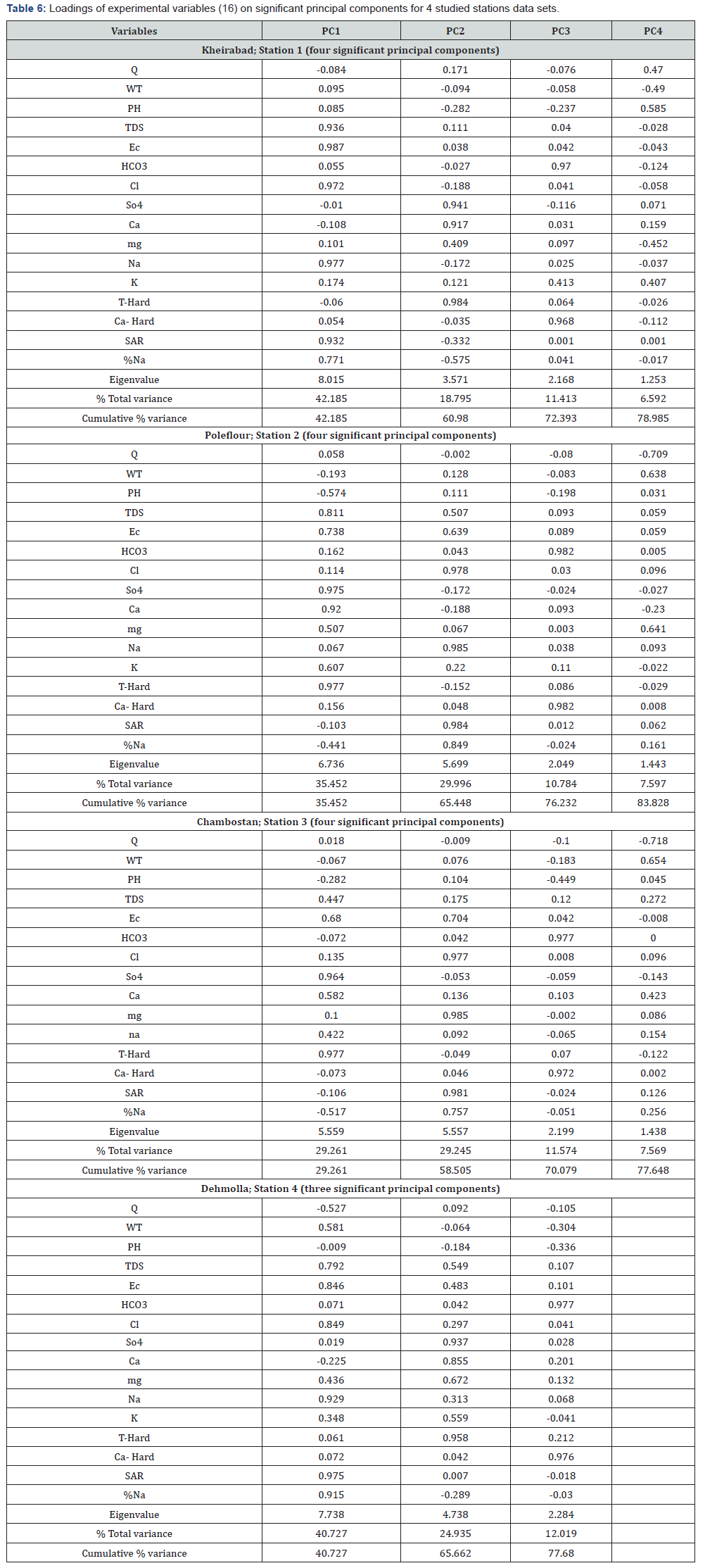
PCA as a powerful pattern recognition technique extracts the variance of a large dataset of intercorrelated variables with a smaller set of independent variables Hopke [22], Simeonov [10]. In the current study PCA was applied on collected dataset to compare the compositional patterns between the examined water samples and identify the factors that influence each one S Singh, Raju, Gossel and Wycisk [23]. The input data matrices (variables _ cases) for PCA were [16 _ 203] for station1, [16_277] for station 2, [16_ 533] for station 3 and [16 _ 541] for station 4. PCA of the four data sets yielded four PCs for the stations 1, 2 and 3 and three PC for the station 4 with Eigenvalues >1, showing 78.985, 83.828, 77.648, and 77.68 % of the total variance in respective Zohreh river water quality data sets. The significance of the factors was evaluated by Eigenvalue. The highest Eigenvalues attributed the most significant factors. Eigenvalues of 1.0 or greater are mentioned significant Kim and Mueller [24]. Table 6 demonstrated the corresponding PCs, variable loadings and explained variance. According to the classification presented by Liu et al Liu, Lin and Kuo [18], the factor loadings as ‘strong’, ‘moderate’ and ‘weak’, are corresponded to absolute loading values of >0.75, 0.75- 0.50 and 0.50 - 0.30, respectively. For the data set relevant to station 1, among four PCs, PC1, explaining 42.185 % of total variance, has strong positive loading on TDS, EC, Cl, Na, SAR and %Na. PC2, explaining 18.795% of the total variance, has strong positive loadings on SO4, Ca and total hardness. PC3, explaining 11.413% of the total variance, has strong positive on HCO3 and Ca hardness, PC1 explains the mineral component of the river water that contributed in water salinity and can be interpreted as a mineral component of the river water.
This classification of variables points to a common origin for these minerals, likely from dissolution of limestone and gypsum soils Ahmadi [13]. The Zohreh River Delta one of the largest deltaic plains along the northern coast of the Persian Gulf, is affected by long-term delta progradation. Gypsum and salt crystal are frequently grown in supratidal and intertidal zones of Zohreh delta because of a dominantly arid climate Gharibreza [14]. Moreover, some literature indicated that there is an increasing trend in salinity of Zohreh river because of huge amount of sugarcane culture withdrawals, discharging of domestic and industrial wastewaters into the river, heavy evaporation due to the hot weather in the region and infiltration of brine Persian Gulf water into the Zohreh river Ahmadi [13], Gharibreza [14], Ghraib Reza and Masoumi [20], Karami, Goudarzi, Dehghani and Mousavi [25,26]. The ionization of dissolved inorganic solids (including minerals, salts, metals, cations or anions) that dissolved in water represents Electrical conductivity. furthermore, in comparison of humid and sub-humid areas, irrigation water salinity in arid and semi-arid areas such as Zohreh river basin is much higher Bauder, Waskom and Davis [27].
Electrical conductivity, SAR and % NA are considered as a useful and reliable measure of water salinity (Ogunfowokan, Obisanya and Ogunkoya [28]. For the data set representing the station 2, among total four significant PCs (83.82%), PC1, explaining about 35.452% of total variance, showed strong positive effects on TDS, So4, Ca and total hardness. This factor represents the contribution of non-point source pollution caused by Chamshir faults I and II fault zone which is the main cause of Zohre river salinity and led to intrusion of sulfate brackish and chloride brine waters to Zohreh river Ahmadi [13], Attari and Mojahedi [29]. PC2, explaining about 29.96 % of total variance, has strong positive loading on Na, Cl and SAR, which similarly showed the hazard of salinity in this river. PC3, explaining about 10.784 % of total variance, has strong positive loadings on HCLO3 and Ca-Hard. This varifactor showed that hydrolysis of Ca, Na, Cl and SO4 cause an increasing in in water Ca hardness and alkalinity. PC4, explaining 7.59 % of total variance, has moderate positive loadings on Mg, water discharge and temperature. This factor represents the erosion effect and increasing of water discharge due to draining of rural, agricultural, urban and industrial areas along the river and discharge into the Zohreh River Ahmadi [13] which led to increasing on water discharge and temperature. PC1 for station 3 explains 39.26% of the variance and is strongly contributed to SO4 and total hardness and moderately contributed to EC and Ca. PC2 explains 29.245 % of the variance and positively includes Cl, Mg and SAR. PC3 explains 11.574% of variance that is positively contributed to HCO3- and Ca hardness. PPC (7.569 % of variance) is contributed moderate loading on water discharge negatively, and loading on water temperature, positively. This factor can be explained taking into account that effect of huge evaporation in this station on decreasing river water discharge. Finally, for the data set pertaining to water quality in station 4, which explains 77.68% of total variance, PC1 explaining 40.727% of variance is strongly contributed to TDS, EC, Cl, Na. This factor can be interpreted as representing influences from nonpoint sources that mentioned before. PC2, explaining 24.93% of total variance, has strong positive loadings on SO4, Ca and total hardness, and PC3 explaining 12.01% of total variance, has strong positive loadings on HCO3- and Ca hardness [30].
Conclusion
There are numerous complicated data at any monitoring programs that require multivariate statistical treatment for analyzing and interpretation of the information. PCA showed the best results in spatial and temporal variations of studied parameters. DA, for four stations of the basin, reduced largely in data sets, as it used only seven parameters (water discharge, water temperature, electrical conductivity, alkalinity, total hardness, Cl concentration and % Na) affording more than 58.5 % correct assignations temporally. So, DA was applied successfully in statistical analyzing to reduce the dimension of the huge data set and describe a less parameters responsible for large variations in water quality. Moreover, four PCs obtained from PCA indicate that the parameters responsible for Zohre water-quality deterioration are mainly related to soluble salts (anthropogenic) and salinity pollution load (natural). Thus, it is suggested that effective river water quality management may achieves by using multivariate statistical techniques, which are useful tools to analysis and interpretation of complex data sets, and in evaluating of water quality, distinguish of pollution sources and the temporal and spatial variations in water quality parameters for.
References
- Bricker OP, Jones BF (1995) Main factors affecting the composition of natural waters. Trace elements in Natural Waters; Eds Salbu B, Steinnes E 1-20.
- Singh KP, Basant A, Malik A, Jain G (2009) Artificial neural network modeling of the river water quality-a case study. Ecological Modelling 220(6): 888-895.
- Vega M, Pardo R, Barrado E, Debán L (1998) Assessment of seasonal and polluting effects on the quality of river water by exploratory data analysis. Water research 32(12): 3581-3592.
- Dixon W, Chiswell B (1996) Review of aquatic monitoring program design. Water research 30(9): 1935-1948.
- Barakat A, El Baghdadi M, Rais J, Aghezzaf B, Slassi M (2016) Assessment of spatial and seasonal water quality variation of Oum Er Rbia River (Morocco) using multivariate statistical techniques. International Soil and Water Conservation Research 4(4): 284-292.
- Fan X, Cui B, Zhao H, Zhang Z, Zhang H (2010) Assessment of river water quality in Pearl River Delta using multivariate statistical techniques. Procedia Environmental Sciences 2: 1220-1234.
- Iscen CF, Emiroglu Ö, Ilhan S, Arslan N, Yilmaz V, et al. (2008) Application of multivariate statistical techniques in the assessment of surface water quality in Uluabat Lake, Turkey. Environmental monitoring and assessment 144(1-3): 269-276.
- Magyar N, Hatvani IG, Székely IK, Herzig A, Dinka M, et al. (2013) Application of multivariate statistical methods in determining spatial changes in water quality in the Austrian part of Neusiedler See. Ecological Engineering 55: 82-92.
- Wang J, Liu G, Liu H, Lam PKS (2017) Multivariate statistical evaluation of dissolved trace elements and a water quality assessment in the middle reaches of Huaihe River, Anhui, China. Science of The Total Environment 583: 421-431.
- Simeonov V, Stratis J, Samara C, Zachariadis G, Voutsa D, et al. (2003) Assessment of the surface water quality in Northern Greece. Water research 37(17): 4119-4124.
- Singh KP, Bhardwaj R (2015) Statistical, time series, and fractal analysis of full stretch of river Yamuna (India) for water quality management. Environ Sci Pollut Res 22(1): 397-414.
- Razmkhah H, Abrishamchi A, Torkian A (2010) Evaluation of spatial and temporal variation in water quality by pattern recognition techniques: A case study on Jajrood River (Tehran, Iran). Journal of Environmental Management 91(4): 852-860.
- Ahmadi M, Ravanbakhsh M, Ahmadi K, Ramavandi B (2015) Trend analysis of long term water quality for Zohre river water, Iran. Pollution Research 34(3): 489-496.
- Gharibreza M, Habibi A, Imamjomeh SR, Ashraf MA (2014) Coastal processes and sedimentary facies in the Zohreh River Delta (Northern Persian Gulf). Catena 122: 150-158.
- Alberto WD, Del Pilar DM, Valeria AM, Fabiana PS, Cecilia HA, et al. (2001) Pattern Recognition Techniques for the Evaluation of Spatial and Temporal Variations in Water Quality. A Case Study: Suquı́a River Basin (Córdoba-Argentina). Water research 35(12): 2881-2894.
- Singh KP, Malik A, Mohan D, Sinha S (2004) Multivariate statistical techniques for the evaluation of spatial and temporal variations in water quality of Gomti River (India)-a case study. Water research 38(18): 3980-3992.
- Helena B, Pardo R, Vega M, Barrado E, Fernandez JM, et al. Temporal evolution of groundwater composition in an alluvial aquifer (Pisuerga River, Spain) by principal component analysis. Water research 34(3): 807-816.
- Directive C 80/778/EEC of 15 July 1980 relating to the quality of water intended for human consumption as amended by Council Directives 81/858/EEC and 91/692. EEC (further amended by Council Regulation 1882/2003/EC).
- Collins R, Jenkins A (1996) The impact of agricultural land use on stream chemistry in the Middle Hills of the Himalayas, Nepal. Journal of Hydrology 185(1-4): 71-86.
- Ghraib Reza M, Masoumi H (2007) Zohreh River Morphology and its variation in Hendijan Delta. Paper presented at the Proceedings of the 7th International River Engineering Conference (in CD). Shahid Chamran University, Ahvaz.
- Mortatti J, Probst JL (2003) Silicate rock weathering and atmospheric/ soil CO2 uptake in the Amazon basin estimated from river water geochemistry: seasonal and spatial variations. Chemical geology 197(1-4): 177-196.
- Hopke PK (1985) Receptor modeling in environmental chemistry: John Wiley & Sons.
- Singh S, Raju NJ, Gossel W, Wycisk P (2016) Assessment of pollution potential of leachate from the municipal solid waste disposal site and its impact on groundwater quality, Varanasi environs, India. Arabian Journal of Geosciences 9(2): 131.
- Liu CW, Lin KH, Kuo YM (2003) Application of factor analysis in the assessment of groundwater quality in a blackfoot disease area in Taiwan. Science of The Total Environment 313(1-3): 77-89.
- Karami KA, Goudarzi M, Dehghani M, Mousavi S (2007) Application of MIKE21 Software in Flood Routing of Tidal Rivers: A Case Study of the Zohre River River (In persian). water and waste water 60: 89-96.
- Bauder T, Waskom R, Davis J (2007) Irrigation water quality criteria. Colorado State University. US Department of Agriculture.
- Ogunfowokan AO, Obisanya JF, Ogunkoya OO (2013) Salinity and sodium hazards of three streams of different agricultural land use systems in Ile-Ife, Nigeria. Applied Water Science 3(1): 19-28.
- Attari J, Mojahedi S (2009) Water sustainability index: Application of CWSI for Ahwaz County. Paper presented at the World Environmental and Water Resources Congress 2009: Great Rivers.
- Subramani T, Elango L, Damodarasamy S (2005) Groundwater quality and its suitability for drinking and agricultural use in Chithar River Basin, Tamil Nadu, India. Environmental Geology 47(8): 1099-1110.






























